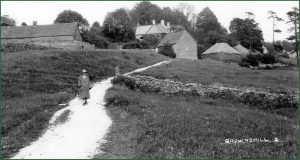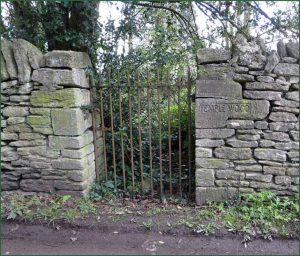Brownshill is the least known settlement within the Chalford Parish, but may be the oldest. It borders the ancient Bisley Common (now partially occupied by Manor Farm Estate in Bussage) and occupies land once owned by the Bishop of Winchester (circa 1523) to finance the building of Corpus Christi College Oxford. The original hamlet of Brownshill is found in a secluded south-western corner of the parish, on a hill top spur between Toadsmoor and Golden Valley. The older part of the village covers the steep slopes that formed the southern boundary of Bisley Common. In terms of land Brownshill occupies a large area stretching north to Frithwood and the recreation ground, east to Old Neighbouring and Skaiteshill, and west to The Bourne. The village existed in a simple form as early as the 1530s, as people settled on common land (squatters rights). There is archaeological evidence of several interesting stones relating to ancient religious buildings, the most notable being the possible site of a Chapel (stone carving suggests Tudor, but it could be older), associated with Bisley Church. An ancient Tithe Barn and shepherd’s stone hut have both been demolished.
The 1869 enclosure act brought an end to the squatter developments. By 1891 there were around 418 people living in the hamlet, in some 96 homes. Today the population is around 220, living in some 110 homes. In the 1940s the village had three shops, the last of which (the PO shop) closed about 25 years ago. The milk dairy along with the “Paraffin Store” has long since closed along with the Railway Tavern pub. This was an old-fashioned pub run by Stella Gardiner, and frequented by local people from Brownshill and The Bourne. A regular customer was Roy Stevens, who brought his pet fox into the Tavern. Another pub, Mount Pleasant on the edge of Brownshill, adjacent to Periwinkle Lane, was the sight of various gruesome murders including one corpse buried under the boundary hedge.
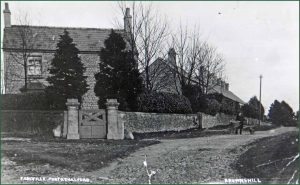
Brownshill was on the main coaching route from Stroud to London before the London Road (now A419) was built along the valley bottom. The original coaching house remains as one of the oldest buildings (recorded as mid-late 18th century) on the convergence of two previously named London Roads (one later re-named as St Mary’s Way by the Roman Catholic community). From the 1950s to the late 1980s the main route out of the village was down Blackness. This steep single-track lane was open to 2-way traffic and considered by the locals as “taking your life in your hands”. There were numerous accidents, breakdowns & cars turning over until the road closed in 1988.
Brownshill had numerous small stone quarries. Besides the well-known 50ft deep quarry opposite the Post Office (at St Margaret’s) there are signs of quarries throughout the village (e.g. Beech Lane, Sycamore Ridge, Mutton Lane & Skaiteshill). Whilst at one time there were four farms in Brownshill, only two remain (but not as fully working farms). The village milk parlour was located at Hermits Cottage, opposite The Spot. Jellyman’s farm, located behind Brownshill House, was bought by the religious orders and sadly has mostly disappeared with time. Vine Farm was at one time the Barley Mow public house. Skaiteshill Farm (previously Home Farm) occupies the site of a beautiful old Cotswold stone tithe barn demolished some 70 years ago.
View from “The Banks” showing Vine Farm stone barns and the only known photograph of Tanglewood. Photo courtesy of Philip Pearson.
The Spot cottages were constructed in 1820 for Thomas Keble’s “clerk of works” who supervised the building St Michael’s Church in Bussage. Initially the site of this church was to be in Brownshill, north west of Brownshill House. However it was decided that the location was too remote from the centre of the congregation and it was transferred to its current site, problematical due to the instability of the ground. The flat area of the original site is still visible in Brownshill.
Brownshill had a strong community identity with a communal allotment in the post war period, and a “Thrift Club” run by Mr. Pratt & Mr. Alan Birmingham. The purpose was to help the working people of the village save for Christmas. The club had a good interest rate with sums paid into individual families’ accounts whenever possible. As elsewhere, there were great differences in wealth within the village. Several larger houses were inhabited by the more affluent, whilst most people were poor and rented basic or even primitive cottages with little or no facilities. Most cottages still had wells within their gardens into the 1950s with main drainage only arriving in Brownshill during the 1960s.
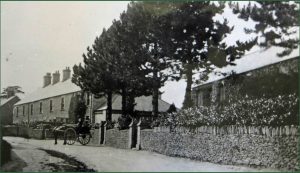
Places of Worship
Brownshill has a distinctive lineage of religious and spiritual healing, over many years. The possible site of a Tudor Chapel has been referred to above. Ancient building stones were found in the garden of Tanglewood House, Brownshill, as reported by Bill Collins (Head Gardener for the Convents) in 1987 to Philip Pearson. An interesting stone gargoyle was unearthed by Godfrey Jellyman’s father when farming the land directly below Tanglewood (pre-WWII). It appears that the house was built on the site of an ancient, thick-walled building, possibly a priest’s house, close to a rock-cut well with three steps leading down to it. Further investigations unearthed various religious stone artefacts including a double lancet window, consecration cross and unusual water channels and vessels. An archaeologist has confirmed the gargoyle was of the Tudor Period and was probably Minchinhampton Stone. Other researchers have suggested that dressed stones from a 13th century church form part of Vine Farm stone barn, and that the Railway Tavern included part of an altar stone in its front porch.
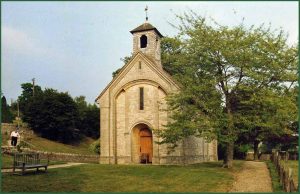
Miss Kessler and Miss Hudson, who had experienced and witnessed trauma as First Aid Nursing Auxiliaries moved to the village after the First World War. They bought a property built in 1891, Tanglewood House, and renamed it ‘The Templewood Home of Rest’ (or the Brownshill Health Colony). The community was devoted to healing women suffering with mental illness. When the women converted to Catholicism they built in the grounds of the house a chapel, St Mary of the Angels, designed by architect W.D. Caröe, a major figure in the Arts and Crafts Movement. The chapel closed in 2011, but was purchased by the villagers and passed into the care of the Friends of Friendless Churches. It now has occasional use for charitable functions as well as an annual art exhibition and Bob Porter’s music venue. Templewood itself was destroyed in 1946 when a Lancaster bomber crashed onto the house. The plane had taken off from Aston Down, clipped a tree over Frith Wood and came down. The crew of two were killed when both the plane and the building burst into flames. Until quite recently the stone ruin at Templewood was in places over 15’ high, but has now been mostly demolished.
The gate to Templewood (originally named Tanglewood – circa 1897) House
The Misses Hudson and Kessler bought several other properties in Brownshill – including cottages and Vine Farm – to house the nuns, priests and provide employment to people with learning disabilities. This was a concern for some villagers who felt their community somewhat taken over by this Catholic initiative. A new building also went up in St Mary’s Way as St Raphael’s, to house the community displaced from Templewood. The Roman Catholic community changed over the years, becoming a Convent and was renamed The Little Company of Hope.
Firwood House, built around 1890, also had a private (C of E) chapel attached to it. The estate belonged to brother and sister William Edmund Smyth (1858-1950) and Ethel Mary Julia Smyth (1861-1958). Edmund had been the 1st Bishop of Lebombo, Africa, whilst Ethel had been a missionary & painter. The adjoining housing development is named Smythe Meadow.
Finally there were two corrugated iron, or “Tin Chapels” in the village. The congregation of Christ Church in Chalford Vale financed the building of a C of E “Tin Tabernacle” in the early 1900s to provide an alternative and more accessible place of worship in Brownshill, and to counteract the Catholic influence. This was called The Hermitage and was recently demolished. The other tin chapel was Brownshill Mission Hall (originally a Christian Brethren Chapel in 1900) where a Sunday School was run by Mr. & Mrs. Davis of Bussage. In the final years of the Sunday School a Brownshill resident, Mr. Graham Hobbs, ran the Sunday School in this hall.

